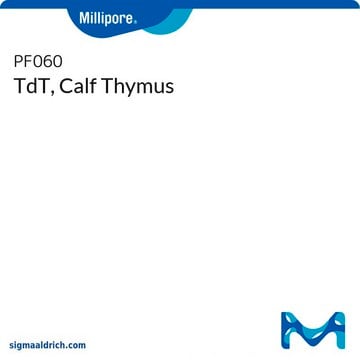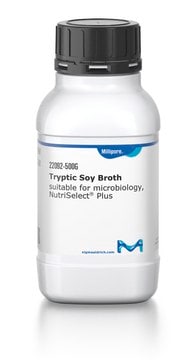KEM0032
Terminal deoxynucleotidyl Transferase (TdT)
Ultra-pure enzyme for nucleic acid modifications
Se connecterpour consulter vos tarifs contractuels et ceux de votre entreprise/organisme
About This Item
Produits recommandés
Qualité
for molecular biology
Essai
>99% (SDS-PAGE)
Forme
buffered aqueous solution
Activité spécifique
27,400 U/mg
Concentration
20,000 U/mL
Conditions d'expédition
dry ice
Température de stockage
−20°C
Description générale
Terminal deoxynucleotidyl transferase (TdT) is a template-independent DNA polymerase that catalyzes the addition of deoxynucleotides to the 3′ hydroxyl terminus of single or double stranded DNA molecules. The presence of 1 mM Co2+ stimulates the tailing of the 3′-ends of DNA fragments. This construct is sold as an N-terminal truncation of the terminal transferase gene attached to an N-terminal fusion tag.
Application
Suitable for:
- Homopolymeric tailing to the 3′ OH
- TUNEL assay
- 5′-RACE
- Labeling of 3′ ends
Caractéristiques et avantages
- Ultra-purification process for ultimate enzyme performance
- Highest quality specifications for ultimate product consistency
- Undetectable DNA and nuclease contamination
Composants
Supplied with:KEM0043B (10X Green Buffer)KEM0045B (2.5 mM CoCl2
Définition de l'unité
1 unit is defined as the amount of polymerase required to convert 1 nmol of dTTPs into acid insoluble material in 1 hour at 37° C.
Forme physique
Supplied in 50 mM KPO4, 100 mM NaCl, 1.0 mM DTT, 0.1 mM EDTA, 0.1% Triton™ X-100, and 50% glycerol at pH 7.3 @ 25° C.
Autres remarques
Source of protein: An E. coli strain that carries the cloned terminal transferase gene from calf thymus.
Unit size: 6,000 U
Informations légales
Triton is a trademark of The Dow Chemical Company or an affiliated company of Dow
Produit(s) apparenté(s)
Réf. du produit
Description
Tarif
Mention d'avertissement
Danger
Mentions de danger
Conseils de prudence
Classification des risques
Aquatic Chronic 3 - Carc. 1B
Code de la classe de stockage
6.1C - Combustible acute toxic Cat.3 / toxic compounds or compounds which causing chronic effects
Faites votre choix parmi les versions les plus récentes :
Déjà en possession de ce produit ?
Retrouvez la documentation relative aux produits que vous avez récemment achetés dans la Bibliothèque de documents.
Laure Rittié et al.
Journal of cell communication and signaling, 2(1-2), 25-45 (2008-09-04)
Since molecular cloning has become routine laboratory technique, manufacturers offer countless sources of enzymes to generate and manipulate nucleic acids. Thus, selecting the appropriate enzyme for a specific task may seem difficult to the novice. This review aims at providing
Notre équipe de scientifiques dispose d'une expérience dans tous les secteurs de la recherche, notamment en sciences de la vie, science des matériaux, synthèse chimique, chromatographie, analyse et dans de nombreux autres domaines..
Contacter notre Service technique








